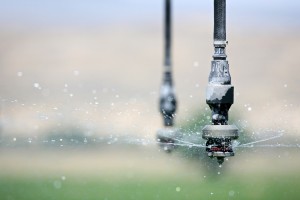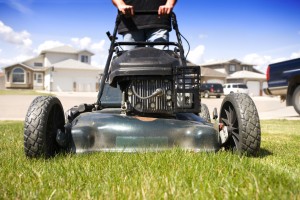Posted by Jamin Howard on Sep 25, 2013 in Lawn Care | 0 comments
http://www.hgtv.com/gardening/planting-a-lawn/index.html
How to Plant a Lawn
Do you want to turn your scruffy lot into a lush lawn? We’ve got just the help for you. Read on to lean how to plant a lawn, whether from sod or from seed.
Excerpted from Garden Design

Simple Steps: Vegetable Gardening ©Dorling Kindersley Limited 2009 The velvet green of a well-maintained lawn is the perfect foil for border flowers. Lawns create a sense of space in the garden and provide color, even in the depths of winter.
The best time to plant, or seed, a new lawn is early fall or spring. Dig the area, adding a margin of 6 inches, and improve the drainage of heavy clay and wet soils by working grit into the topsoil. For free-draining soils, dig in a 3 to 4 inch layer of bulky organic matter to conserve moisture and fertility. Depending on the size of your yard, it should take you about a day to plant your lawn.
Materials Needed:
- spade or fork
- rake and hoe
- all-purpose granular fertilizer
- topsoil mixed with horticultural sand
- wooden plank
- broom
- garden hose
- sharp spade
Posted by admin on Jan 29, 2013 in Lawn Care | 1 comment

It’s simply amazing how a mid-summer drought can burn out a lawn, turning it brown and dry. More amazing still, is how the return of rain and cooler temperatures will bring back that lush, green growth. In most cases, lawns will come back with little or no long-term damage. Nature certainly built toughness into most grasses. Many of us want lush, green lawns all year. So, watering is an important part of a healthy, green lawn. Here are some tips and ideas for proper watering to assure maximum benefit to your lawn.
Did you know? Rain falls at about 19 miles per hour.
People will water their lawns day or night, whenever it is convenient. Some people (and many businesses, apartments, and golf courses) employ automatic sprinklers, and water in the middle of the night or in the wee hours of the morning before dawn when people are not out and about. The choice of timing is generally a matter of convenience……when are you home to water your lawn? Regardless of the answer, it is important to know the advantages and disadvantages of day versus nighttime watering.
Daybreak or just before dawnis the ideal time to water your lawn. Evaporation is at a minimum, and the rising sun will quickly dry the grass, reducing the likelihood of disease. Unfortunately, many of us have a day job to go to, and find it difficult at best, to go out in morning before work to get the hoses and sprinklers working.
Daytime-Daytime is also a good time to water your lawn. You can pour on generous amounts and allow it to soak in. The blades of grass dry quickly, minimizing the risk of plant disease. The major disadvantage is it takes more water. Evaporation steals a portion of the water you apply, before it can soak in and reach the grass roots.
Nighttime-A lot of us choose nighttime and the hours just before dark for two reasons. First, is the simple fact that we are home. After dinner is the time many of us devote to caring for our lawns and yards. We also know that the water we apply will not be robbed by the sun through evaporation. The major disadvantage is plant disease thrives in wet, humid conditions. The water sits on the blades of grass all night, improving the breeding ground for disease.
Did you know? One of the best times to water your lawn is when it is raining. Often, summer rains are too light to add any real benefit. Supplementing the rainfall with your sprinkler gets the water down to a sufficient depth to water all of the roots. Remember, we are talking about light summer rains, not thunder storms or heavy downpours. Give it some thought….give it a try.
How much and How often? General wisdom is to water your lawn deeply once or twice a week. Apply one to one and a half inches or water each time. Light, daily watering leaves too much water at or near the surface of the soil, and does not reach all of the roots where it is needed. Deep watering allows moisture to reach the deepest roots. Allowing the soil to dry between watering will encourage the roots to go deeper to reach the moisture and nutrients it needs. Daily, light watering will cause the roots of your grass to become dependent upon you to provide the water that it needs. So, train your lawn, before it trains you!
Posted by admin on Jan 29, 2013 in Lawn Care | 0 comments

Here are some mowing tips and instructions that you will find useful, especially for new homeowners:
Cut lawns when it reaches 2-3 inches in length.
Cut no more than 1/3 of the grass blade length at a cutting.
Alternate cuttings, going horizontally and vertically across the lawn. For a neat look, cut the lawn diagonally.
Leave grass clippings on the lawn to decompose. As they decompose, they provide natural, organic nitrogen to the lawn, keep moisture in, and helps to minimize weeds. Always mow when the lawn is dry. This will save wear and tear on your mower. It will also keep cut grass from clumping on the lawn, and minimize the spread of disease.
Check the mower blade regularly to assure a sharp cut. Dull blades will hack and chop the blade, leaving unattractive ragged, brown edges, and risking lawn damage.
Mowing your lawn at a longer length provides a longer grass blade to absorb sunlight and photosynthesis, helping to create a healthier lawn. High mowing, as it is called, also helps block out crabgrass and weeds.